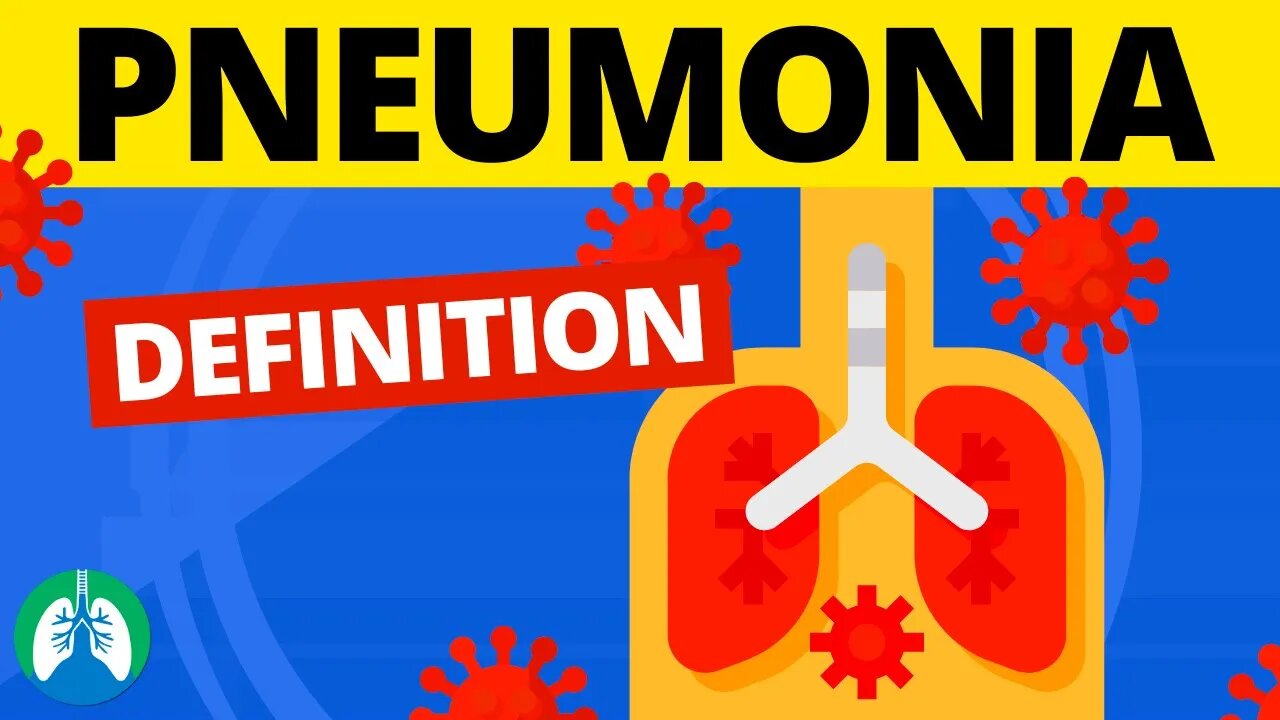Premium Only Content

What is Pneumonia? (Medical Definition)
What is Pneumonia? This video covers the basics of pneumonia and provides an overview of the medical definition.
💥Full Guide on Pneumonia ➜ ➜ ➜ https://bit.ly/2LXMg7b
➡️ Causes
Pneumonia has several different causes including viruses, bacteria, fungi, and even parasites in some cases.
➡️ Signs and Symptoms
The signs and symptoms of pneumonia can vary in severity from patient to patient. With that said, here are some of the most common examples:
▪ Productive cough
▪ Fever and chills
▪ Tachypnea
▪ Shortness of breath
▪ Chest pain
▪ Diaphoresis
▪ Fatigue
▪ Cyanosis
Keep in mind that other signs and symptoms of Pneumonia do exist. These are just some of the most common examples.
➡️ Types of Pneumonia
The type of pneumonia is often classified according to how the patient acquired the disease. Here are the different types:
▪ Community-Acquired Pneumonia (CAP)
▪ Hospital-Acquired Pneumonia (HAP)
▪ Ventilator-Associated Pneumonia (VAP)
▪ Aspiration Pneumonia
The name of each type pretty much gives away what it means:
▪ CAP is when a patient gets Pneumonia outside of the hospital.
▪ HAP is when the patient gets it during a hospital stay.
▪ VAP is when it’s acquired while the patient is on a mechanical ventilator.
▪ Aspiration Pneumonia is acquired when a patient aspirates bacteria into the lungs, usually from food, saliva, or stomach acid.
➡️ Diagnosis
Pneumonia is most commonly diagnosed by looking at the patient’s chest x-ray which will show signs of consolidation. Other tests and findings to look for include:
▪ Vital signs
▪ Arterial Blood Gas (ABG) results
▪ Pulmonary Function Tests (PFT)
▪ Sputum culture
▪ Complete Blood Count (CBC)
➡️ Treatment
Pneumonia should be treated on a case by case basis but, in general, here are the most common treatment methods:
▪ Antibiotic medications
▪ Oxygen therapy
▪ Bedrest
▪ Airway clearance therapy
▪ Hyperinflation therapy
▪ Fluid management
Now again, each patient will be treated differently depending on the cause and severity of symptoms. And in severe cases, intubation and mechanical ventilation would be indicated.
💥Full Guide on Pneumonia ➜ ➜ ➜ https://bit.ly/2LXMg7b
—————
📗 BEST STUDY GUIDES FOR YOU
▪ TMC Test Bank 👉 http://bit.ly/2IGeqSu
▪ Hacking the TMC Exam 👉 http://bit.ly/2XBc8do
▪ TMC Exam Bundle (Save $) 👉 https://bit.ly/34pqEsV
▪ Daily TMC Practice Questions 👉 http://bit.ly/2NnXh3C
💙MORE FROM RTZ
▪ Free TMC Practice Exam 👉 http://bit.ly/2XlwASL
▪ Free RRT Cheat Sheet 👉 http://bit.ly/2IbmOKB
▪ Resources for RT's 👉 http://bit.ly/2WVV5qo
▪ Testimonials 👉 http://bit.ly/2x7b5Gl
🌐FOLLOW US
▪ Instagram 👉 http://bit.ly/2FhF0jV
▪ Twitter 👉 http://bit.ly/2ZsS6T1
▪ Facebook 👉 http://bit.ly/2MSEejt
▪ Pinterest 👉 http://bit.ly/2ZwVLPw
🚑MEDICAL DISCLAIMER
Medicine and Respiratory Therapy are continuously changing practices. The information in this video is for educational and entertainment purposes only. For medical advice, please consult with a physician or qualified medical professional.
💡AFFILIATE DISCLAIMER
This description contains affiliate links. If you decide to purchase a product through one of them, we receive a small commission at no cost to you.
—————
⏰TIMESTAMPS
0:00 - Intro
0:20 - Causes
0:32 - Signs and Symptoms
1:02 - Types of Pneumonia
1:55 - Diagnosis
2:06 - Vital Signs
2:17 - Treatment
—————
🖼CREDIT FOR MUSIC AND GRAPHICS:
▪ Graphics: www.canva.com
▪ Graphics: www.freevector.com
▪ Graphics: www.vecteezy.com
▪ Graphics: www.pngtree.com
#Pneumonia #RespiratoryTherapy #RespiratoryTherapist #RespiratoryTherapySchool
-
 3:17
3:17
Respiratory Therapy Zone
1 year agoWhat is Silicosis? (EXPLAINED) 🫁
444 -
 1:15:15
1:15:15
Glenn Greenwald
5 hours agoWeek in Review: Lee Fang and Leighton Woodhouse on Ukraine War and NYT Piece Revealing Tensions within Trump Admin; PLUS: Lee Fang Takes Audience Questions on DOGE and Big Tech | SYSTEM UPDATE #420
61.4K39 -
 1:03:30
1:03:30
Sarah Westall
7 hours agoMassive Government Overhaul: FBI, CIA, IRS and more to be Gutted w/ Sam Anthony
73.7K15 -
 1:07:40
1:07:40
IsaacButterfield
7 hours ago $2.82 earnedAustralia Under Attack | Trump's State of the Union | All LGBTQ Cast (W Guest Frenchy)
33.9K7 -
 1:23:37
1:23:37
Edge of Wonder
7 hours agoIs Your Car Collecting Your Biodata? Whistleblower Exposes Dark Agenda
33.7K7 -
 2:08:50
2:08:50
Quite Frankly
10 hours ago"A Rat at HHS, Gene Hackman, Musical Extras" ft. J Gulinello 3/7/25
37.7K7 -
 55:49
55:49
LFA TV
1 day agoGermany Started Two World Wars and Now Wants Nuclear Weapons | TRUMPET DAILY 3.7.25 7PM
33.9K25 -
 1:34:38
1:34:38
2 MIKES LIVE
6 hours ago2 MIKES LIVE #189 Open Mike Friday (Sort Of)
25.5K -
 1:48:14
1:48:14
Right Side Broadcasting Network
14 hours agoLIVE REPLAY: President Trump Delivers Remarks at The White House Digital Assets Summit - 3/7/25
147K42 -
 2:07:17
2:07:17
The Quartering
11 hours agoTrump Goes Ballistic On Russia & Ukraine Gets Results, Democrat Cringe, FBI Arrests Military Men
144K79